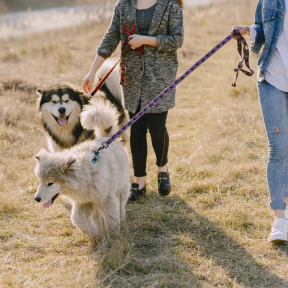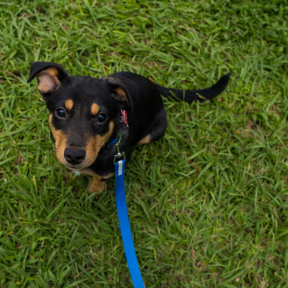How to Run With Your Dog
Posted by EzyDog on 9th Aug 2023
So, you want to run with your dog? Welcome to the starting line!
Running is commonly considered to be a strenuous form of exercise – and that’s BEFORE adding a dog to the mix. Any runner knows that enduring exercise and overcoming adversity merits a great reward, and being able to do that with a companion elevates that experience to a whole new level.
One of the greatest challenges of running with a dog is the fact that you are two different species. Canines have four legs and are amongst nature’s fastest land animals while humans run on two feet and are known to be the most efficient long-distance runners on the planet. The difference is enough to make you wonder how humans and dogs even became best friends in the first place. Finding common ground and learning to move as a unit is the key to mastering the art of running together.
Yes – running with dogs poses challenges that may seem too difficult an undertaking to even consider, but it’s entirely possible and virtually anyone can do it. At EzyDog, we compile years of experience living active lifestyles with our dogs and creating the solutions that allow them to join in the adventures we enjoy most, so we have a wealth of knowledge and tips to share that will help you ease the stress and give you a running start to packing on miles with your pup!
Here’s what we’ll be covering:
- Why you should
- The gear you need to get started
- Training
- Communicating with your dog
- Nutrition
- Planning
- What to expect during your run
Why You Should Run With Your Dog
Running with your dog promotes numerous health benefits such as a stronger heart, lungs, and improved circulation for both humans and canines. Exercising together also strengthens your bond. Running together as a “pack” is an opportunity to express your similarities and improve their trust in you as their pet parent.
Exercising together with your best friend is also far and away more mentally stimulating than running by yourself. You and your dog will be constantly attuned to one another as you traverse twists and turns while overcoming obstacles in new ways. With your mind focused on the task and your dog, you’ll find yourself thinking less about fatigue and more about how much fun you’re having.
Canine running buddies are also great motivators. They’ll gladly jump at every opportunity to adventure alongside you and keep you committed to exercising regularly.
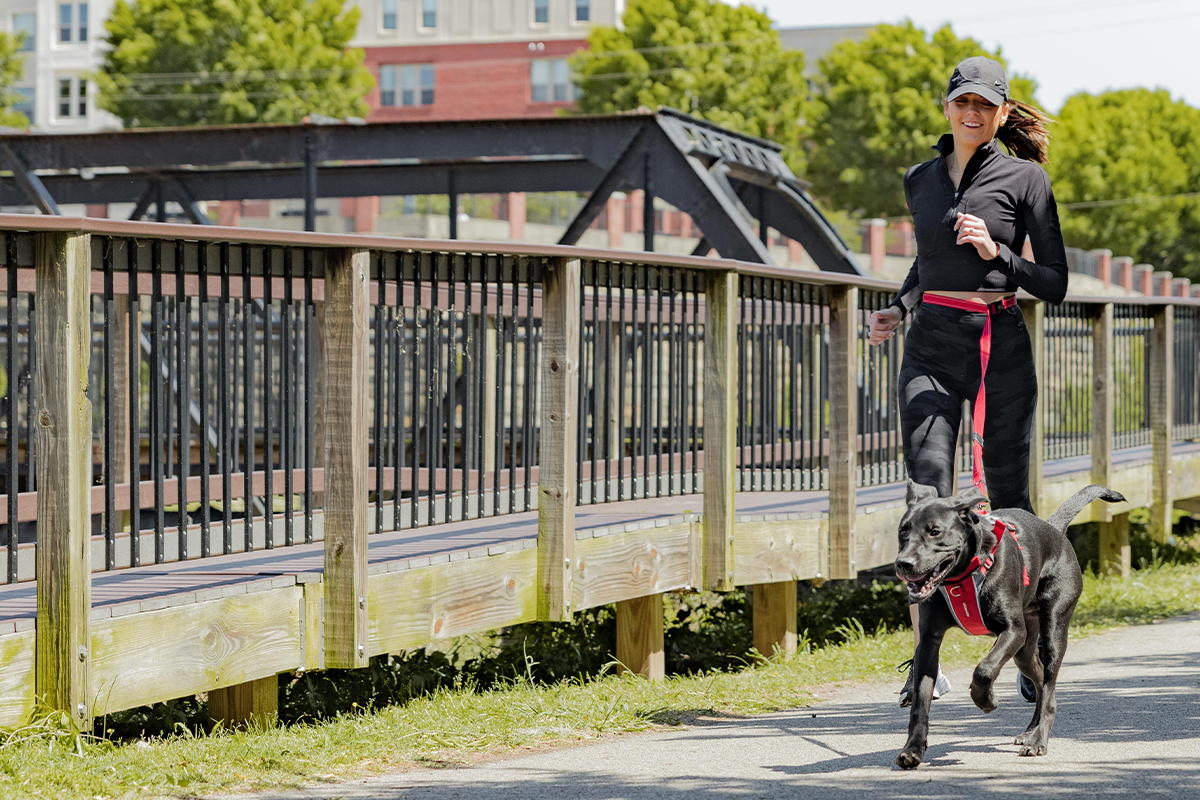
Best Dog Running Gear
Shock Absorbing Dog Leash
- Our top pick is the Road Runner Leash. It features a hands-free design that can also be used as a temporary tether when taking a break. The patented Zero Shock Technology provides an unparalleled buffer that reduces the shock of sudden movements and stops that happen frequently when running with dogs.
Running Dog Harness
- A harness is always better than a collar for high-impact exercise due to the stress a collar can put on a dog’s neck. There are several good options for harnesses, but we recommend the X-Link or Chest Plate Harness for the best experience due to their comfort, security, and freedom of movement. The X-Link is a better choice for dogs that tend to pull hard – more on that later.
Folding Water Bowl
- Dogs don’t sip water from a bottle or hydration pack like we do – they slurp. Since water availability can be uncertain, we recommend bringing some with you and a Fold-A-Bowl dog bowl. It’s ultra-light and can be attached to the Road Runner Leash’s bounce-free accessory attachment.
Treats and/or Kibble storage
- Keeping treats or other edibles for your dog is important for rewarding good behavior and keeping dogs motivated. If carrying these in your pockets seems gross, we recommend the SnakPak GO Treat Bag, which has a magnetic pouch and additional storage space for things like those jingling car keys everyone loves to listen to while they run.
Poop Bags
- Stepping in dog doo is a great way to ruin any adventure. Be a good steward and keep the trails clean. For quick, convenient access to poop bags, the EzyDog Doo Bag dispenser is a fantastic solution that you can attach directly to your leash, hydro-pack, or virtually anywhere – be creative!
Dog Light
- In case you end up in low-light situations, the GO2 Multi Dog Light is a light and bright safety solution that will make your dog visible. It can attach directly to your dog, or you can clip it to your leash to keep it handy for when you need it.
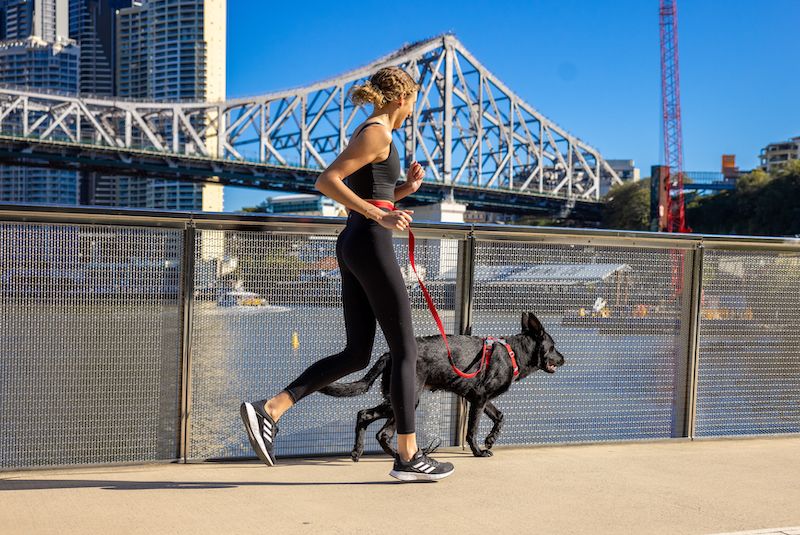
How to Train Your Dog To Run With You
Before you begin, we strongly recommend you consult a veterinary professional to ensure your dog is healthy enough to run. Be sure to ask their recommendation what kind of distance your dog is capable of running based on their breed, age, and personality – this advanced knowledge will help you prepare for what lies ahead. You may also need to alter your dog’s diet by introducing nutrients or additional calories, just like a human athlete.
Training your dog to run is very similar to any other kind of dog training where positive reinforcement and repetition set the foundation for success. Since most dogs start exercising at a high-energy level, you’ll want to focus on getting them to maintain a controlled pace, rewarding them with a treat or kibble when they exhibit good running behavior. Always, always, always give your dog verbal praise when giving them a treat to help them recognize that it’s their reward for doing the right thing. You may also benefit from a clicker, where they can also recognize the ‘click’ as a trigger for reward.
One of the best ways to learn something new is to jump in and start doing it, but it’s paramount to have realistic expectations. Start with an open mind and short jogs as short as 400 meters (approx. ¼ mile), close to home if possible. Because all dogs are unique and different, this will give you an opportunity to identify any areas that need work. Be sure to pay attention to your body language as well to make sure you’re keeping on pace and focused – your dog will be looking to you for guidance as they adapt to this new venture. As you progress, pay close attention to how they’re moving and look for signs of fatigue. If your dog is panting excessively, slow down or stop as needed. This is how you find your dog’s exercise limit – the point from which you both can grow together.
We recommend doing these short bursts together for at least a week before attempting your first real run. It will give you both an opportunity to prepare yourselves for what’s next in the weeks ahead.
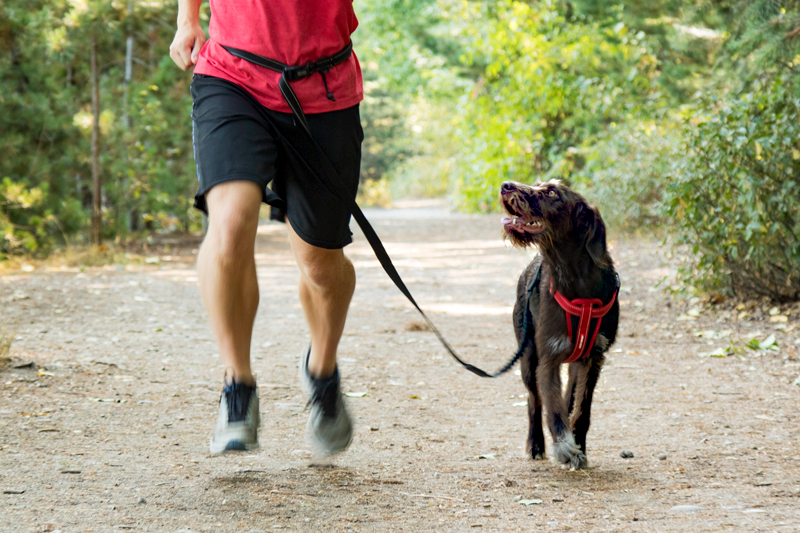
Communicating With Your Running Buddy
Another important component of running with your dog is being able to communicate with them effectively. Since you’ll be moving faster than normal, you need to be able to react faster and be keen to your surroundings as you move forward.
While you generally want a dog to walk calmly beside you, allowing them to lead while running on-leash has benefits. Seeing them trot ahead while you run behind is enlivening and inspiring. Allowing them to lead can help you keep pace and avoid slouching. The gentle push-and-pull of the leash helps you to feed off each other’s energy. The biggest challenge you’ll run into with your dog leading the way is that they don't always know the direction you want them to go, but that can be remedied with cues.
We’ve already touched on using your voice for positive reinforcement. That’s good - keep doing that! Another way you can use your voice is verbal commands. Many of these you probably already use such as: “let’s go!”, “stop”, or “easy!”. Dogs can quickly learn what these words mean, especially if your body language reflects the notion.
We strongly encourage teaching your dog audible cues for “left”, “right”, and “straight”. The forks in the trail and sidewalk turns come even faster when you’re running, and being able to warn your dog of which direction you’ll be going will keep your leash relaxed and prevent them from going the wrong way. If there’s one thing we can all glean from sled dog racing, it’s that using the terms “Ha” for left and “G” for right actually work. Ultimately you can teach your dog to respond to any sound you make. Dynamo (one of the EzyDog shop dogs) has learned to respond to slight variances in tongue clicks for left and right, and the command “go straight” when the desire is to keep moving forward.
Another way you can communicate with your dog is by touch. Your leash is your landline to your dog. They can feel every tug, and you can use that to your advantage to by tugging sideways to notion a desire to turn, pulling back when you want them to slow down or stop, and giving them extra slack when you want them to go fast (like loosening the reins when riding a horse). And don’t forget to give them a head pat from time to time to encourage their good effort!
Dogs can get smelly when they run, but your dog’s sense of smell is a superpower that tells them a lot more about you. While you cannot control the scents in the air, they can learn how to respond to various smells based on how you react to situations where that smell is present. And remember, a dog’s nose knows when you’re getting tired. They can even use their nose to navigate trails or find their way home, whereas we must rely on memory and sense of direction (or technology).
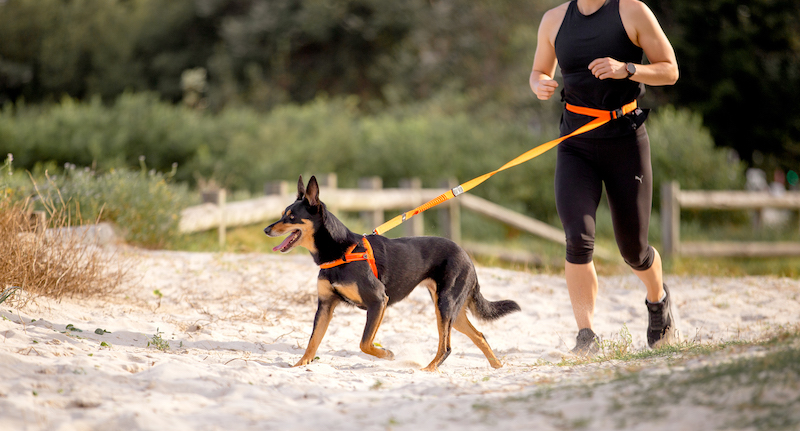
Nutrition For Dogs That Run
Just like us, our dogs that exercise at a high level should maintain a proper diet. It’s recommended that a diet should contain at least 25% of protein, ideally from meat, to avoid skeletal injuries. Meat is also a good source of fat. When changing their food plan, it’s important to introduce the new diet slowly.
During exercise, reward them with small treats or kibble. And keep it light! Small nibbles are enough. When you’re feeding your dog an athlete diet, you want to avoid excess calories to keep them fit.
If you plan to run more than 30 minutes, your dog will need water. Even if you know there’s natural water such as creeks and streams available during your run, bring some with you just in case. Clean water from home is better than having your dog gulp standing water, which can expose them to dangerous parasites. If you have your Fold-A-Bowl handy, you can share some of your own water with them. You may also consider natural drinking opportunities on your route, but always familiarize yourself with the water quality in your area the best you can before letting your dog drink it.
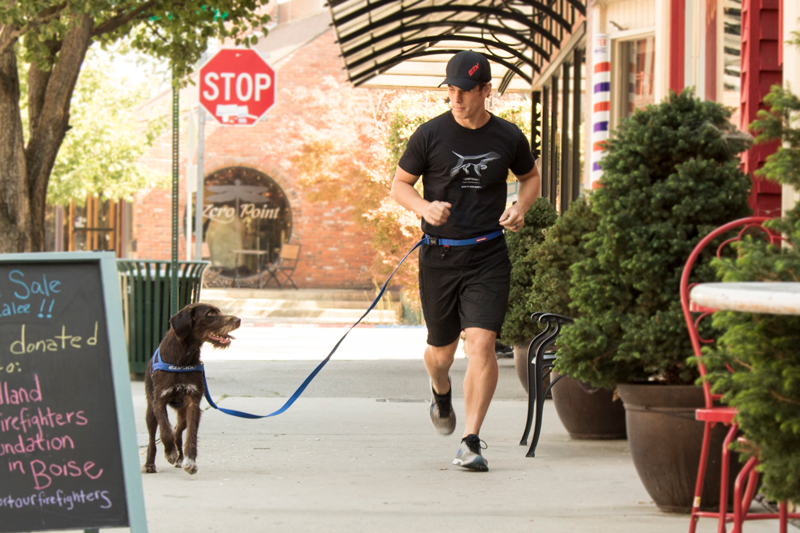
Planning A Run With Your Dog
Set low expectations for your first run. Review a checklist, be it an actual list or mental, of all the gear you’ll need before you start running. Whether you’re running a loop or out-and-back, keep your first run to 1-2 achievable flat miles. Adventures with more elevation gain may require more practice to sync correctly with your dog because most dogs tend to pull hard to get up and down hills quickly. Mastering their level of pull will come with experience.
Remember – your dog will feel the heat more than you. If it feels too hot for you, it’s too hot for them. Because dogs are at serious risk of overheating in hot weather, it’s always best to run in the mornings or late afternoon when temperatures are cooler. If possible, choose a route that includes potable water resources. If you must run in the middle of the day, consider sidewalks or trails with plenty of shade to keep your dog cool.
After hours runs on trails can be a great escape from busy daily life, but it’s important to avoid getting caught in the dark if possible. The sun always sets earlier on valley trails between mountains. Sometimes unexpected delays can lead to situations like this, which is part of the reason why most EzyDog gear includes reflective trim. If you brought your dog light with you, you’ll be able to keep track of your dog and illuminate the trail and, if you’re in a more urban area, make yourself visible to traffic.
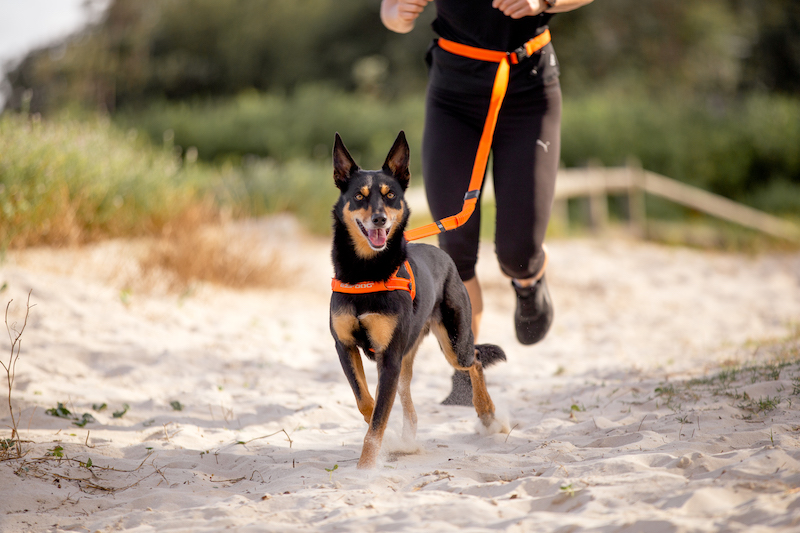
What to Expect
Pre Run
- Stretch and warm up before you begin running, and don’t forget to hydrate in advance. A great way to get your dog ready for exercise is to play with them. This will get their heart up slightly and promote good vascular function during your run. Play fetch, do tricks, wrestle – try a variety of things to learn what you and your dog enjoy most.
- Most dogs and humans are prone to signs of anxiety before runs. It’s good practice to communicate to them that they’re going to go for a “run”, with emphasis to teach them it’s a word to get excited about. Even if you forget, dogs typically watch their humans closely and will learn what’s in store for them as soon as you start putting on your running shoes. Because of that, be sure to get everything ready to go before you touch your shoes to avoid having to manage an overly excited dog during the process.
- Get your leash strapped with all your gear and get your dog into their harness. Make sure their harness is fitting properly and that no straps are getting in the way of their movement. If your dog freezes up and stares at you awkwardly once their harness is on – that’s normal. They’ll forget about it once you get going.
Early Run
- Try to start off easy. Most dogs aren’t privy to the art of saving energy and tend to take off full sprint once you get moving. Use your voice to get them to ease up and slow down your own pace if necessary until you find a comfortable rhythm. This is also where the X-Link harness might come in handy, since it has a front leash attachment which can be used to reduce a dog’s ability to pull.
- Expect to stop early on. Most dogs will feel the urge to do their business at the start of exercise. Make it your business to take care of their business. Once you’re done, carry on!
Mid Run
- This is it – the moment you’ve been waiting for! You and your dog are finally catching pace and moving forward. This is the best opportunity to find your groove and stay synced at a steady pace. You’re fluidly feeding off each other’s energy. They might slow down to sniff occasionally but keep them motivated with pets and entice them with treats. Expect to pause and say “hi” to other dogs you encounter. Socializing is good for your dog but try to keep it brief.
- You may notice your dog is sneaking bites of grass as they move. This is normal. Although there’s not a clear consensus to why dogs do this, it’s important to keep them from eating grass that’s been fertilized or treated with herbicides.
- Watch your dog closely. Panting is normal and how they vent their body heat. Take water breaks as needed to keep them refreshed.
Late Run
- Whether you’re at the end of your planned distance or not, you may start to notice your dog slowing down. Try to soften your stride so they can keep up. If they’re panting excessively and still moving slow after verbal motivation, you may need to proceed with walking or stop to take an extended break to let them recover. It’s OK to stop early. Just like us their endurance will improve with regular exercise.
Post Run
- After running, your dog will generally be tired. Lead them to a shaded or air-conditioned area where they can cool off and fill up a bowl of fresh water for them to rehydrate. Some dogs prefer to cool off before drinking water after exercise, but others might start drinking right away.
- Remain in the vicinity of your dog while they recover. This is a good time to stretch and hydrate yourself and offer them some words of praise for their hard effort to let them know you’re proud of them – that will help them stay committed to being your running partner.
- Once your dog seems to be breathing normally, it’s a good idea to engage in some low-level activity. Have them do some tricks in exchange for some recovery treats or kibble or have them walk around with you. Be sure to give their stomach time to recover before feeding them a meal. If your dog just wants to rest, that’s totally fine as well – they earned it!
- Don’t forget to end the day with a dog wash – just like with us, a good cleaning after exercise will make them feel refreshed.
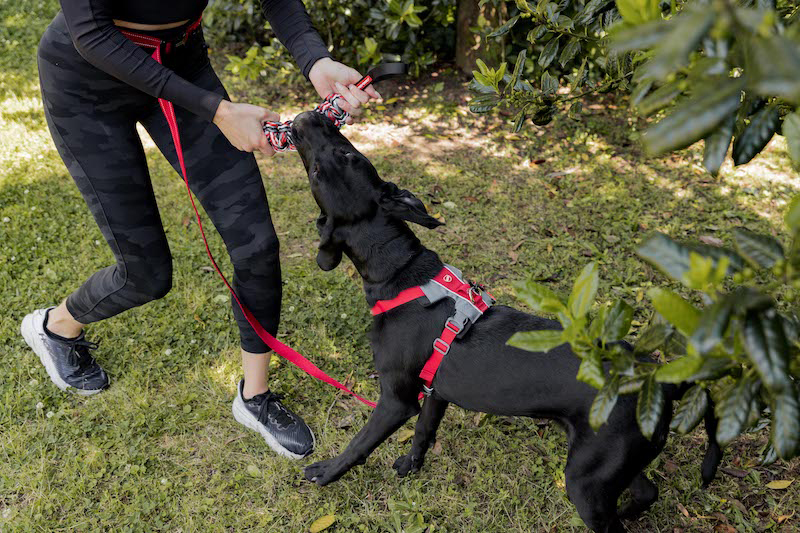
Looking Ahead – What To Do After Running With Your Dog?
Just like all things, it can take some time and effort to really feel comfortable running with your dog. Set a goal and take it slow. Build up your distance over time. The more you and your dog run together, the easier the outings become. As you incorporate regular exercise as part of you and your dog’s routine, you will find yourselves connecting on a whole new level. With practice and repetition, you and your dog will fall into a similar mindset learning to navigate the trails and sidewalks in a way conscious of one another’s abilities.
Endless, exciting adventures await. Each day, be grateful for the chance to exercise with your best friend as you stride toward your goal. But remember, the best part of reaching that goal is the journey – a long-distance journey that you’ve embarked on together.
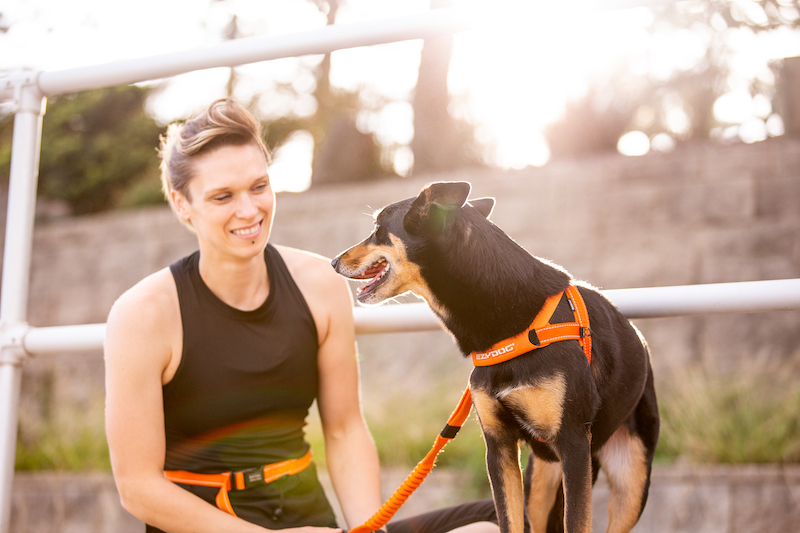
NOW GO AND PLAY!


